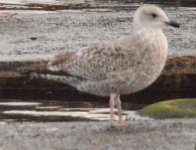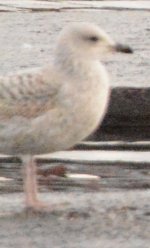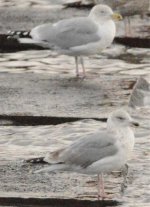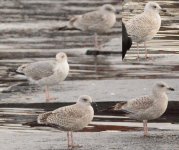-
Welcome to BirdForum, the internet's largest birding community with thousands of members from all over the world. The forums are dedicated to wild birds, birding, binoculars and equipment and all that goes with it.
Please register for an account to take part in the discussions in the forum, post your pictures in the gallery and more.
You are using an out of date browser. It may not display this or other websites correctly.
You should upgrade or use an alternative browser.
You should upgrade or use an alternative browser.
request for Gull id , Preston UK (1 Viewer)
- Thread starter Earnest lad
- Start date
More options
Who Replied?Earnest lad
Well-known member
SteveClifton
Well-known member
Dear Aeshna - Thank you
Please may I ask also: Are these all Herring Gulls too?
Yes they are
Earnest lad
Well-known member
Thats most helpful thank you. I was hoping against hope for a Common GullYes they are
stevethehydra
Well-known member
Common Gull is much smaller than Herring - closer in size to a Black-headed, though closer to Herring in plumage and structure. One among Herring Gulls should be quite obvious!
Earnest lad
Well-known member
Common Gull is much smaller than Herring - closer in size to a Black-headed, though closer to Herring in plumage and structure. One among Herring Gulls should be quite obvious!
Thank you for pointing this out. I must go back to Preston Dock and try and pick one out. I am keen to get on to one
Thank you for pointing this out. I must go back to Preston Dock and try and pick one out. I am keen to get on to one
Around here playing fields in the winter seems to be favourite habitat for Common Gull. Much darker back/mantle than Herring.
Rotherbirder
Well-known member

Thank you for pointing this out. I must go back to Preston Dock and try and pick one out. I am keen to get on to one
As aeshna5 says, docks and coastal habitats are not the best for finding Common Gulls. Checking loafing or feeding gull flocks on playing fields, inland reservoirs, country parks with lakes etc is the way to go for finding Common Gulls in winter.
RB
Earnest lad
Well-known member
Around here playing fields in the winter seems to be favourite habitat for Common Gull. Much darker back/mantle than Herring.
As aeshna5 says, docks and coastal habitats are not the best for finding Common Gulls. Checking loafing or feeding gull flocks on playing fields, inland reservoirs, country parks with lakes etc is the way to go for finding Common Gulls in winter.[/QUOTE]
Thank you both. I dont see many Common Gulls in fields around Bolton or Manchester. Please do you know of any good spots as I am keen to get some photo's. I read online that although it is called "Common" it is in fact not always one of the most commonly seen.
Stephen Dunstan
Registered User
As aeshna5 says, docks and coastal habitats are not the best for finding Common Gulls. Checking loafing or feeding gull flocks on playing fields, inland reservoirs, country parks with lakes etc is the way to go for finding Common Gulls in winter.
Thank you both. I dont see many Common Gulls in fields around Bolton or Manchester. Please do you know of any good spots as I am keen to get some photo's. I read online that although it is called "Common" it is in fact not always one of the most commonly seen.[/QUOTE]
Preston Dock is a perfectly good place for Common Gulls in winter. Just wait until the roost / pre-roost forms towards dusk and they join the Black-headed Gulls bathing. There are better options if you want photographs though.
Nutcracker
Stop Brexit!
Still very common in Northumbs in the winter - generally the most numerous gull (often by a very large margin) in the big inland reservoir gull roosts, e.g. 16,000 at Derwent Reservoir in December 2018.
This is a decline on past numbers though, e.g. 50,000 at Hallington Reservoirs in March 1991 and November 1995, and 48,000 at Derwent Reservoir in December 1998.
This is a decline on past numbers though, e.g. 50,000 at Hallington Reservoirs in March 1991 and November 1995, and 48,000 at Derwent Reservoir in December 1998.
Earnest lad
Well-known member
Thanks everyone.
It seems the eastern counties of the north are more favoured than the nw, but I shall keep a look out in fields if I see gulls feeding when passing in the car.
It seems the eastern counties of the north are more favoured than the nw, but I shall keep a look out in fields if I see gulls feeding when passing in the car.
BuzT
Well-known member
Gulls are nearly always a challenge because they have such a wide variety of plumages for each species. Makes them really interesting. Adults in breeding plumage are relatively easy but you are dealing with non breeding plumage. So size is important. Colour of legs. Beak colour and features and then the plumage. At a quick look you have one bird whicch is still in breeding plumage with white spots on the tail, pink legs and yellow beak with red spot. Herring gull. The others, by and large have pink legs, indeterminate bill colour with a black tip and grey brown mottled colouring. Herring gulls, probably 2nd or 3rd winter birds.
Earnest lad
Well-known member
Gulls are nearly always a challenge because they have such a wide variety of plumages for each species. Makes them really interesting. Adults in breeding plumage are relatively easy but you are dealing with non breeding plumage. So size is important. Colour of legs. Beak colour and features and then the plumage. At a quick look you have one bird whicch is still in breeding plumage with white spots on the tail, pink legs and yellow beak with red spot. Herring gull. The others, by and large have pink legs, indeterminate bill colour with a black tip and grey brown mottled colouring. Herring gulls, probably 2nd or 3rd winter birds.
I like to get a nice close in shot of a bird then when I get home carefully examine the features such as the ones you mentioned, to try and determine the species. I have been able to get some lifers this way, and I have had quite a few lifers because of help received on this forum to nail an id.
Users who are viewing this thread
Total: 2 (members: 0, guests: 2)







